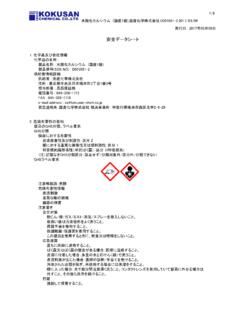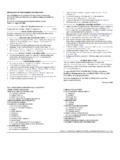Transcription of Direct Routing for Microsoft Phone System with ... - Cisco
1 Application Note Public Direct Routing for Microsoft Phone System with Cisco Unified Communications Manager (UCM) via Cisco Unified Border Element (CUBE) 2 November, 2020 Application Note Application Note 2020 Cisco Systems, Inc. All rights reserved. Important notices, privacy statements, and trademarks of Cisco Systems, Inc. can be found on Page 2 of 11 Table of Contents Introduction .. 3 Network Topology .. 4 Direct Routing deployment with On-Premises Cisco UCM .. 4 Deployment & Call Routing Options .. 5 Tested Topology and System Components .. 7 Cisco UCM .. 7 CUBE .. 7 Cloud Infrastructure .. 7 End Points .. 7 Features .. 8 Summary of Features/Scenarios 8 Limitations .. 9 Solution Configuration Guidance .. 10 Configuring Microsoft Phone System .
2 10 Configuring Cisco UCM .. 10 Configuring CUBE .. 10 2020 Cisco Systems, Inc. All rights reserved. Important notices, privacy statements, and trademarks of Cisco Systems, Inc. can be found on Page 3 of 11 Introduction Customers using Microsoft Phone System have the option of not only connecting to the public switched telephone network (PSTN) using a certified Session Border Controller (SBC), such as the Cisco Unified Border Element (CUBE) but also to an internal Phone System such as Cisco Unified Communications Manager. This document describes deployment scenarios, supported features, and recommendations for successful interworking between Cisco Unified Communications Manager (UCM) release and Direct Routing for Microsoft Phone System using Cisco Unified Border Element (CUBE) This document should be used in conjunction with the following resources: Direct Routing for Microsoft Phone System with CUBE Application Note CUBE PSTN interoperability documentation Cisco UCM design guides Cisco UCM administration/configuration guides This document assumes that the reader is knowledgeable with the terminology and configuration of Direct Routing for Microsoft Phone System with CUBE described in the application note above.
3 Only those details specific to interworking with Cisco UCM are addressed in this document. Testing was performed in accordance with Direct Routing for Microsoft Phone System test methodology with Media Bypass disabled in a lab environment. 2020 Cisco Systems, Inc. All rights reserved. Important notices, privacy statements, and trademarks of Cisco Systems, Inc. can be found on Page 4 of 11 Network Topology Direct Routing deployment with On-Premises Cisco UCM Figure 1: Network Topology The network topology includes the Microsoft Phone System , Microsoft Teams client, CUBE, Cisco UCM, IP Phones, and the PSTN Microsoft 365 Admin Center is used to configure a gateway trunk associated with the CUBE public FQDN The trunk between CUBE and Microsoft Phone System uses TLS/SRTP The trunk between CUBE and Cisco UCM uses UDP/RTP Cisco UCM has a PSTN connection that may use the same CUBE or a dedicated PSTN GW.
4 The configuration of that is out of the scope of this documentation This solution allows calling between Microsoft Phone System clients and Cisco UCM clients or the PSTN via CUBE 2020 Cisco Systems, Inc. All rights reserved. Important notices, privacy statements, and trademarks of Cisco Systems, Inc. can be found on Page 5 of 11 Deployment & Call Routing Options Deployment Coresident Direct Routing SBC Where a common CUBE instance is used to connect Microsoft Phone System to both Cisco UCM and the PSTN. Call Routing There are two principal ways in which call Routing can be configured with a coresident SBC deployment. Call Routing with Cisco UCM This is where all calls, regardless of destination are routed via Cisco UCM. This centralizes dial plan management and is a recommended solution.
5 When a coresident PSTN GW is used, a call from Microsoft Phone System will route through CUBE to Cisco UCM and then back to CUBE to the PSTN trunk. Figure 2: Coresident Direct Routing SBC and PSTN GW with UCM Call Routing Call Routing with CUBE This is where calls between Microsoft Phone System and the PSTN are routed directly by CUBE. This solution may be chosen in a coresident PSTN gateway deployment to reduce the number of call legs. Routing calls from the PSTN towards Cisco UCM or Microsoft Phone System may require the management of a more detailed CUBE dial plan. Figure 3: Coresident Direct Routing SBC and PSTN GW with CUBE Call Routing 2020 Cisco Systems, Inc. All rights reserved. Important notices, privacy statements, and trademarks of Cisco Systems, Inc.
6 Can be found on Page 6 of 11 Deployment Dedicated Direct Routing SBC Where there is a dedicated CUBE instance for Direct Routing and an additional gateway used for connection to the PSTN. Call Routing There is one principal way in which call Routing can be configured with a dedicated SBC deployment. Call Routing with Cisco UCM This is where all calls, regardless of destination are routed via Cisco UCM. This centralizes dial plan management and is a recommended solution. A call from Microsoft Phone System will route through CUBE to Cisco UCM and then to the PSTN GW. Figure 4: Dedicated Direct Routing SBC with UCM Call Routing The PSTN connection in any of these scenarios could be an ITSP SIP Trunk or an Analogue/TDM connection. An ITSP SIP Trunk was used for Cisco testing & validation.
7 2020 Cisco Systems, Inc. All rights reserved. Important notices, privacy statements, and trademarks of Cisco Systems, Inc. can be found on Page 7 of 11 Tested Topology and System Components The following components were used in the validation of this solution. Please refer to product specific documentation for further details. Figure 5: Tested Network Topology Cisco UCM Cisco Unified Communications Manager release [Any currently supported version may be used] CUBE Cisco ISR 4000 series router [Any certified platform may be used] CUBE-Version: (IOS-XE ) [Later releases may be used] Cloud Infrastructure Microsoft Office 365 Tenant with Phone System license Media Bypass Off/Disabled (Media Bypass On has not yet been tested with Cisco UCM interoperability) End Points Microsoft Teams client for Windows or Mac [Any client supported by Microsoft may be used, features may vary] Cisco IP Phones running enterprise SCCP or SIP software registered to Cisco UCM 2020 Cisco Systems, Inc.
8 All rights reserved. Important notices, privacy statements, and trademarks of Cisco Systems, Inc. can be found on Page 8 of 11 Features The following details how Cisco UCM features work when interconnecting with Microsoft Phone System using Direct Routing with CUBE. For features independent of Cisco UCM please refer to the Direct Routing for Microsoft Phone System with CUBE application note. Summary of Features/Scenarios Validated Basic call between the two systems and verification of voice path, using both SIP and legacy (SCCP) phones registered to Cisco UCM, and Teams clients registered to Microsoft Phone System1 CLIP/CLIR/CNIP/CNIR features: Calling party Name and Number delivery (allowed and restricted)1 COLP/CONP/COLR/CONR features: Connected Name and Number delivery (allowed and restricted)1 Call Transfer: Attended and Early attended1 Alerting Name Identification1 Call forwarding.
9 Call Forward Unconditional (CFU), Call Forward Busy (CFB), and Call Forward No Answer (CFNA) Hold and Resume with Music on Hold Three-way conferencing1 Voice messaging and MWI activation-deactivation1 Call Park1 Extend and Connect1 Single Number Reach (SNR) provides Cisco UCM users with the ability to be reached via a single enterprise Phone number that rings on both their Cisco IP desk Phone and their Microsoft Teams client (Remote Destination) simultaneously. Users can pick up an incoming call on either their Cisco IP Phone or Microsoft Teams client and at any point can use the Cisco IP Phone to transfer the call between devices without interruption. Centralized voicemail, using Unity Connection integrated with Cisco UCM via SIP. This voicemail solution can provide centralized voicemail services, supporting both Microsoft Phone System and Cisco end-users.
10 1 Refer to Limitations section for further details. 2020 Cisco Systems, Inc. All rights reserved. Important notices, privacy statements, and trademarks of Cisco Systems, Inc. can be found on Page 9 of 11 Limitations The following limitations should be considered when interworking Cisco UCM with Microsoft Phone System using CUBE for Direct Routing : To ensure that mid-call features, such as hold and transfer work correctly, the Cisco UCM SIP trunk to CUBE must be configured to use a Media Termination Point (MTP). When using a Cisco UCM software MTP, calls between Cisco UCM and CUBE use u-law encoding by default. Microsoft Phone System does not support overlap dialing. Microsoft Phone System does not support alerting name updates.















